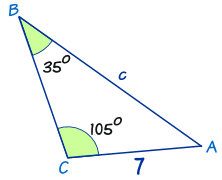This week in pre-calc 11, we learned all about the sine and cosine law
Sine law:
We use sine law to find either a missing angle or a missing side.
To understand the formula, we must understand that a triangle has 3 sides and 3 angles. The side of an angle is it’s opposite. With this triangle, we can see that the side labeled c is opposite to the angle C.
To find a missing angle, we use the formula:
To find a missing side, we use the formula:
We use the sine law when we are trying to figure out an unknown angle or side and the given triangle shows you (or lets you figure out) the information of an angle AND its opposite side.

For an example, .
First step would be to determine which formula to use. Since we are missing a side, we will be using .
Next, we would plug in the numbers that we know into the formula:
Since we only really need one equal sign in our equation we can eliminate one part of the formula that we don’t need since it doesn’t give us any useful information. In this example, we could eliminate
The next step is find c with some basic algebra and some calculations.
To isolate c, we would multiply both sides by
Using a calculators, we can find that